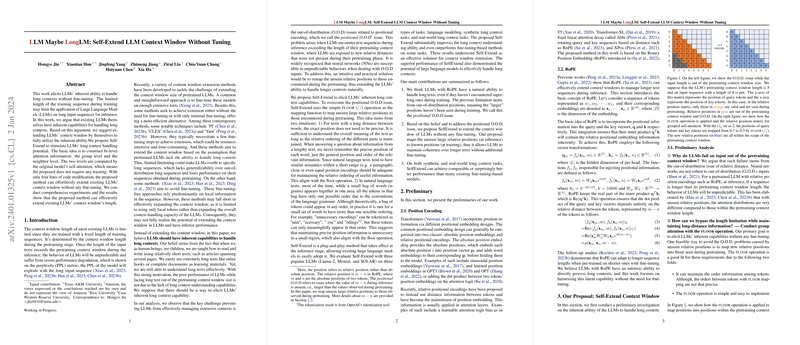Overview
This paper introduces a novel approach, termed Self-Extend, for empowering LLMs to process significantly longer text sequences beyond their original training limitations. The method enables LLMs to recognize and utilize longer contexts without the need for any fine-tuning or additional training. The fundamental premise is that LLMs, akin to humans who can comprehend lengthy texts without being exclusively trained on them, possess an intrinsic capability to comprehend long contexts that has not been fully leveraged.
Methodology
The challenge in handling longer texts by LLMs is often attributed to the relative positional encoding becoming out-of-distribution (O.O.D) when the model encounters sequence lengths beyond its pretraining context window. To address this, Self-Extend proposes a mapping technique that realigns unseen relative positions during inference back to positions encountered during training, effectively mimicking the way humans approximate the relative significance of distant text parts.
This is achieved through what the authors call "grouped attention", which applies a floor operation to partition the text into smaller clusters, allowing preservation of the order of information while reducing the granularity of positional data. Bi-level attention information, with a regular self-attention process for nearby token pairs and grouped attention for distant pairs, allows Self-Extend to precisely model near tokens while also maintaining coherence over the entire text. The method is simple to implement, requiring minimal modification to existing model code.
Experimental Results
Self-Extend's ability to extend context windows is validated through various settings, demonstrating its ability to keep perplexity low and help LLMs maintain performance on long-sequence inputs. The approach is tested against other context window extension methods, specifically on tasks requiring long-sequence understanding such as LLMing, synthetic long context tasks, and real-world long context tasks. Remarkably, Self-Extend often outperforms fine-tuning-based methods despite its non-learning nature and modest implementation requirements.
Implications and Conclusion
The paper concludes by emphasizing the potency of LLMs in handling longer contexts as evidenced by Self-Extend's performance. It highlights the potential cost savings and efficiency gains as Self-Extend requires no additional model training or fine-tuning. As a future direction, the researchers aim to enhance efficiency with Flash Attention implementation and consider advanced mapping strategies to further improve the capacity for extended contexts. They also recognize the current limitations regarding the finite extension of context windows and the necessity for consensus on evaluating long context tasks. Overall, Self-Extend offers a promising step toward fully unlocking the long-context processing abilities of LLMs.
